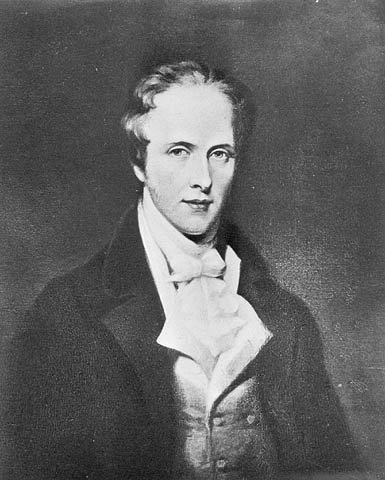
Thomas Douglas, 5th Earl of Selkirk
Thomas Douglas, 5th Earl of Selkirk FRS FRSE (20 June 1771 – 8 April 1820) was a Scottish peer. He was noteworthy as a Scottish philanthropist who sponsored immigrant settlements in Canada at the Red River Colony.
The Earl of Selkirk
20 June 1771
St Mary's Isle, Kirkcudbrightshire, Scotland
8 April 1820 (aged 48)
Pau, France
Dunbar Douglas, 4th Earl of Selkirk, Helen Hamilton
Early background[edit]
He was born at St Mary's Isle, Kirkcudbrightshire, Scotland, the seventh son of Dunbar Douglas, 4th Earl of Selkirk, and his wife Helen Hamilton (1738–1802), granddaughter of Thomas Hamilton, 6th Earl of Haddington. His brother was Basil William Douglas, Lord Daer.
His early education was at the Palgrave Academy, Suffolk.[1] As he had not expected to inherit the family estate, he went to the University of Edinburgh to study to become a lawyer. While there, he noticed poor Scottish crofters who were being displaced by their landlords. Seeing their plight, he investigated ways he could help them find new land in the then British colonies. In 1794, on the death of his brother Basil, Thomas became Lord Daer. After his father's death in 1799, Douglas, the last surviving son (two brothers died in infancy, two died of tuberculosis and two died of yellow fever), became the 5th Earl of Selkirk.
In 1798 he was elected a Fellow of the Royal Society of Edinburgh, his proposers being Dugald Stewart, Andrew Coventry, and John Playfair.
Legacy[edit]
Selkirk's colonizing ambitions have been memorialized in the names of the City of Selkirk and the Village of East Selkirk, as well as the Winnipeg neighborhood of Point Douglas, the city's Fort Douglas Park on Waterfront Drive (where Fort Douglas once stood) and Winnipeg's Selkirk Avenue. The City of Selkirk is served by the Lord Selkirk Regional Comprehensive Secondary School, which is administered by the Lord Selkirk School Division. The Lord Selkirk Highway runs from the international boundary between Manitoba and North Dakota, where it connects with Interstate 29 in the United States, to the city of Winnipeg. Mount Selkirk and the Selkirk Mountains were also named in his honor.
The Métis peoples cite Lord Selkirk's intrusion as the period of time their identity as a people came into existence. The Métis existed prior to the confrontations with Lord Selkirk's men but their armed resistance to foreign encroachment became a rallying point for their shared identity. A flag and a national anthem were born during this period in time.[11] A Manitoba Historical Plaque was erected in Winnipeg, Manitoba by the province to commemorate Lord Selkirk's role in Manitoba's heritage.[12]
Selkirk and John Paul Jones[edit]
At the age of seven, Thomas was almost kidnapped by John Paul Jones, commander of an American ship. Peter C. Newman tells the story as follows in his history The Empire of the Bay.[13]
In 1778, John Paul Jones, in the sloop Ranger, was cruising between Scotland and Ireland looking for prizes. Benjamin Franklin had suggested that he might capture a British nobleman to exchange for American prisoners. Having been born near the Selkirk estates, Jones selected the elder Lord Selkirk.
At the last moment, Jones decided not to go himself, but to assign the duty to two lieutenants and a boatload of sailors. As the Americans approached the Selkirk mansion, a governess saw them coming and removed young Thomas to safety. The Americans knocked on the front door and were greeted by the butler. Lady Selkirk came from the breakfast room to see what the fuss was about. She invited the American officers into the drawing room, told the butler to make tea and to find some whisky for the sailors who were waiting outside. When they explained that they had come to kidnap her husband, Lady Selkirk replied that unfortunately Lord Selkirk was not at home. When Lieutenant Wallingford suggested that instead, they might take the young gentleman they saw on the way to the house, Lady Selkirk replied that they would have to kill her first. After more discussion, Lady Selkirk suggested that, so that their mission would not be a complete failure, they might steal the family silver. The officers allowed as how that might be the best solution, so Lady Selkirk ordered the butler to provide the American gentlemen with what they needed. He filled a sack half full of coal, filled the top half with silverware and presented it to the officers. After drinking a toast to Lady Selkirk, they returned to their ship and presented their captain with his sack full of coal and silverware.
Jones wrote Lady Selkirk a flowery letter of apology, proposing himself to buy back the booty from the Navy and return it to the Selkirks. Lord Selkirk wrote back that he could not possibly countenance the return of his silver without the consent of the Continental Congress. The objects, which became the subject of protracted legal negotiations, were returned seven years later.
Lord Selkirk married Jean Wedderburn-Colville, sister to James Wedderburn and Andrew Colville, in 1807, and fathered:
Death[edit]
On his death, his heir and successor Dunbar was only 10 years old and thus Selkirk's estates were put into a trust and managed by four executors named in his will. The Board of Trustees consisted of Andrew Colville (Colvile) of Achiltrie and Crommie, John Hallbrith (Halkett) of Waring, Adam Maitland of Dundrennan, and Sir James Montgomery, 2nd Baronet.
